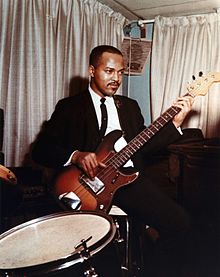I grew up not really realizing what the bass does for music. I could hear guitars, pianos, voices, drums. But what happened on the bottom was invisible to my ears. A degree in music later, I kind of got it, but… After a decade of writing for 4 part acapella, I certainly understood the importance of the bass, but still… It’s taken a pretty full lifetime for me to appreciate the glories of all that goes on down under. Watching this fantastic visualization of Motown great James Jamerson bringing bouncy groovalicious life to Stevie Wonder’s hit helps me really ‘get’ what he is doing – rhythmic, melodic, adventurous, witty genius.
Once you’ve heard/watched the video above, listen to Stevie’s original, and see how the bass just dances around (the bass comes in around 15 seconds into the song). Cool, eh?
A bit about James:
“Motown’s tormented genius, James Jamerson is unanimously acclaimed as the first virtuoso of the electric bass. Plagued by alcoholism and emotional problems throughout his career, James has influenced (whether they know it or not) every electric bassist to ever pick up the instrument. Arriving at Motown in 1959, James’ bass playing evolved over the next decade from a traditional root-fifth cocktail style of bass playing into an astonishing new style built upon a flurry of sixteenth-note runs and syncopations, “pushing the envelope” dissonances, and fearless and constant exploration.
A converted upright bass player with bear claw hands, James plucked the strings with only the index finger of his right hand (which he dubbed “The Hook), and effortlessly and routinely pulled off head-turning, technical feats on the ’62 P-Bass he nicknamed “The Funk Machine.” His explosive, earthquake-heavy bass lines have had the entire world dancing and grooving to Motown records for over four decades. But he labored in total obscurity – a condition that ate at him throughout the last years of his life.” (read more at MetaFilter)

